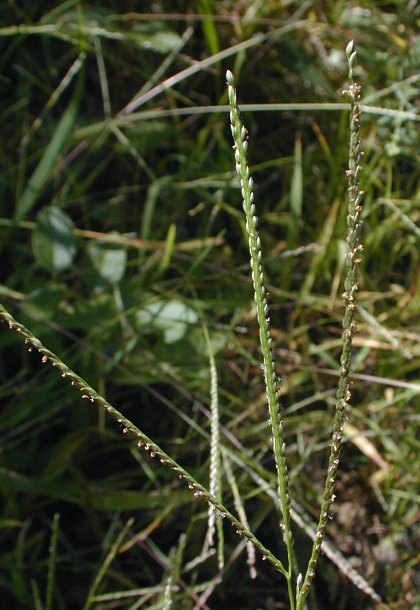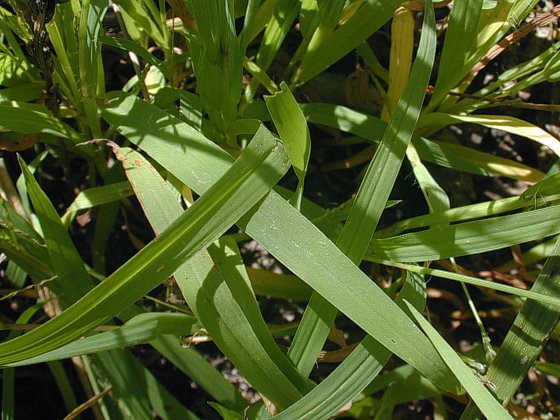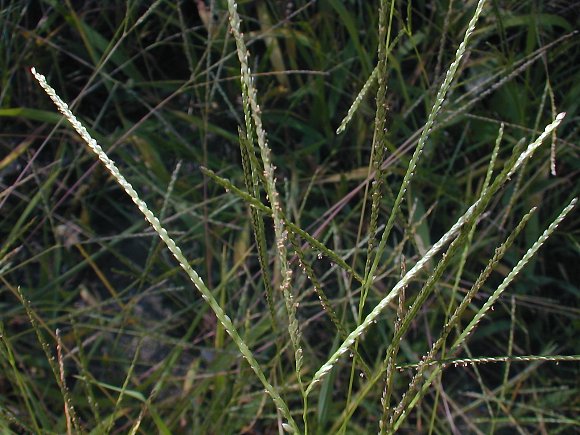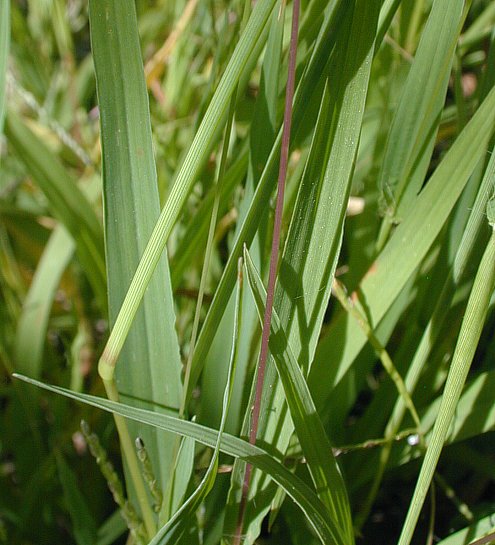Description: This grass is a summer annual about ½–1½' tall that is tufted at the base; its culms branch occasionally. The lower culms are decumbent, while the upper culms are ascending to spreading. Each slender culm is terete, glabrous, and pale green to pale purple. About 2-4 alternate leaves occur along each culm. The leaf blades are up to 4½" long and 8 mm. across; they are light to medium green or blue-green, flat or longitudinally indented, and mostly hairless. Sometimes there are scattered white hairs toward the bases of the blades. The inflated sheaths of the leaves cover most of the culms; these sheaths are longitudinally veined, hairless, and the same color as the blades. The nodes are swollen and glabrous, while the ligules are white-membranous. The upper culms terminate in digitate clusters of 2-7 racemes. These racemes are very narrow, spike-like, and up to 4" long. Each raceme has 2 rows of appressed spikelets that alternate along a rachis (central stalk) about 1 mm. across. The rachis is medium green, angular, somewhat flattened, and glabrous.

The spikelets occur in pairs or individually along each raceme on very short pedicels. The spikelets are about 2 mm. long, ellipsoid in shape, somewhat flattened, and dark green, purplish green, or silvery green. Each spikelet consists of 2 glumes, 2 lemmas, and a single floret. The outer glume is the same length as the spikelet, elliptic in shape, convex along the outer surface, and 3-veined, while the inner glume is small and insignificant. The lemmas are also the same length as the spikelet and elliptic in shape; the sterile lemma is 7-veined, while the fertile lemma is dark-colored and cartilaginous. The perfect floret of each fertile lemma has 2 stigmas, 3 anthers, and an ovary. The blooming period occurs from mid-summer into the autumn. The florets are cross-pollinated by the wind. The small grains are about 1.5 mm. long, broadly ellipsoid in shape, and somewhat flattened. The root system is shallow and fibrous. This grass reproduces primarily by reseeding itself, although it can spread vegetatively by forming rootlets at the lower nodes of its culms.

Cultivation:
This
weedy grass is typically found in full to partial sun, moist to mesic
conditions, and a somewhat heavy soil containing loam or clay-loam. It
can spread aggressively in lawns. Most vegetative growth occurs during
the summer as the seeds are slow to germinate. Because of its C4
photosynthetic metabolism, this grass is able to tolerate episodes of
hot dry weather.
Range & Habitat:
The non-native Smooth
Crabgrass is occasional to locally common throughout Illinois (see Distribution
Map). It is adventive from Eurasia. Habitats include weedy
meadows, trampled ground along paths, fields and pastures, vacant lots,
lawns, edges and cracks of sidewalks, roadsides, and waste areas. Areas
with a history of disturbance are strongly preferred.

Faunal Associations: Various insects feed on crabgrasses (Digitaria spp.), including the caterpillars of two skippers, Atalopedes campestris (Sachem) and Hylephila phyleus (Fiery Skipper), caterpillars of the moth Mocis texana (Texas Mocis), Chaetocnema denticulata (Toothed Flea Beetle) and Chaetocnema pulicaria (Corn Flea Beetle), Myochrous denticollis (Southern Corn Leaf Beetle), Sphenophorus maidis (Maize Billbug), Dichromorpha viridis (Short-winged Green Grasshopper), and such aphids as Anoecia cornicola (White-banded Dogwood Aphid), Sipha flava (Yellow Sugar Cane Aphid), and Tetraneura nigriabdominalis (Rice Root Aphid); see Bouseman et al. (2006), Covell (1984/2005), Clark et al. (2004), Vaurie (1983), Brust et al. (2008), and Blackman & Eastop (2013) for more information. The seeds of crabgrasses are an important source of food to many species of upland gamebirds and granivorous songbirds (see Bird Table). In addition, the foliage is eaten occasionally by mammalian herbivores (e.g., rabbits and livestock).

Photographic
Location:
The trampled ground of a path along a powerline clearance in Busey
Woods, Urbana, Illinois.
Comments:
This weedy Digitaria sp. (crabgrass) is less common
and slightly less aggressive than Digitaria sanguinalis
(Common Crabgrass). The latter species is a little larger in size and
has hairy sheaths; it is more common in dry sunny areas than Smooth
Crabgrass. Both of these species are native to Eurasia, rather than
North America, and they are common pests in lawns. In high quality
natural areas, they are rarely observed. There are also native Digitaria
spp. in Illinois, but they are less common and largely
confined to sandy areas (including sand prairies). They are more erect
than the Eurasian crabgrasses and the stalks of their racemes are more
narrow and wiry (less than 1 mm. across).